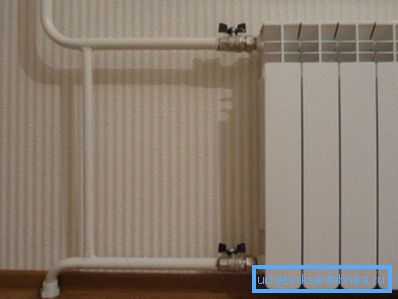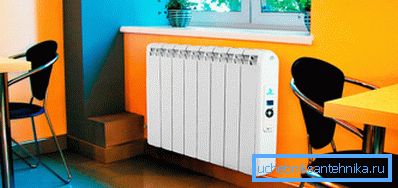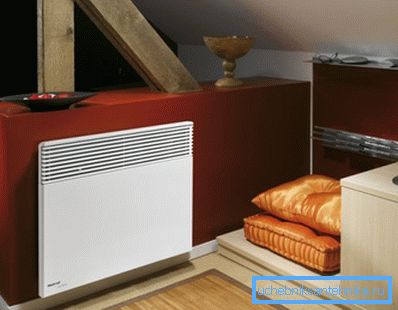Radiators for the home: purpose, types, features of water
Heating radiators for a private house is an important group of appliances on which the comfort of housing and the very possibility of a normal life in the house depend. We want to consider different types of heaters and find out which installation scheme of radiators in a private house is most acceptable.

Radiators for home heating
Purpose

The purpose of any heating device is to provide efficient and safe heating of the room with the lowest cost. For private houses that are not connected to a centralized coolant supply system, the issue of costs is particularly relevant.
The main task of the radiator is the distribution of thermal energy. The heat itself can enter the device using a heat transfer fluid or be converted from electricity in it.

Regardless of the method of obtaining heat, the radiator must perform the following functions:
- Heating of the outer surface of the case and radiation of heat using light in the infrared range. The share of radiated energy is about 50 - 60% of the total heat transfer;
- Air heating by direct heat transfer through direct contact;
- Providing the most appropriate conditions for the active convection of heated gas indoors. The body of the product must have air ducts to create a natural gravitational thrust, and artificial airflow is also possible.

Note! The word "radiator" comes from the Latin "radiator", which literally means "emitter". The title lays the main role of the device - the radiation of heat.
Species

As we have said, radiators can run on a liquid coolant or electrical energy.
Therefore, all types of devices can be divided into two large groups:
- Water heating radiators. They operate on a heat-transfer fluid that is supplied through pipes from the city's heat and power plant or an autonomous heating system boiler;
- Electric convectors. Electro-radiators for a private house are especially relevant in the absence of a gas main. Presented by a large number of species.

Water heating is still the most profitable from an economic point of view. Despite the fact that the installation of the coolant circulation system is not an expensive event, the price of heating a house with its help is much lower than the cost of electricity.
However, this is true when connected to the gas pipeline. If there is no centralized gas supply, the use of coal, diesel fuel or firewood will be a little cheaper, but in terms of convenience, electricity surpasses other types of energy carriers many times.
Heating at home with electric energy alone remains too expensive, but in the absence of alternatives it is a simple, convenient and efficient way out. Most often, electric heating is used as an additional source of heat along with water heating.

Note! Widely used two types of devices: water and electric. The first ones require installation of the coolant supply system, and the second ones are too expensive to operate.
Water radiators

Water heating remains the most profitable and widespread type of housing heating in our country. Therefore, water batteries are the leader in sales among heating appliances.
By type of construction products can be tubular, panel or sectional. The principle of operation is the same: the coolant heats the body of the product, which radiates heat into the room and heats the air in contact with its surface.

Consider the types and features of the apparatus on the liquid coolant:
| Variety heater | Special features |
| Cast iron battery | Affordable price, high strength and reliability, large mass, low efficiency and heat transfer, high thermal inertia. Well suited for centralized coolant supply systems, poorly adjustable in temperature and not suitable for systems with automatic climate control. |
| Tubular register | Low cost, high efficiency and reliability, a large amount of coolant, significant thermal inertia. Well suited for heating large rooms, concert halls, workshops and shopping complexes. A particular example is the heated towel rails in the bathrooms. |
| Steel panel | It is a welded steel plate with a coated profile that forms channels for the circulation of fluid. Differs in rather low power, is afraid of corrosion and water hammer. Due to the small capacity amenable to automatic temperature control |
| Aluminum battery | High thermal conductivity and excellent heat dissipation, high efficiency and power, small capacity and quick response to the adjustment. Ideal for autonomous heating systems, demanding on the quality of the coolant, the acidity of the medium and the pressure parameters in the system |
| Copper convector | Maximum thermal conductivity, heat transfer and efficiency, high reliability and strength, no corrosion and long service life. The only drawback of the copper battery is too high cost, otherwise it is the most qualitative type of devices. |
| Bimetal radiator | Combines the strength of steel or copper with thermal conductivity and lightness of aluminum. Inside the aluminum case, a steel or copper core is pressed in, as a result, the products are distinguished by durability and high heat transfer. The most progressive and compromise option |

Note! Instructions for installing a water heating system with their own hands is quite complicated and requires knowledge in the field of plumbing, boiler equipment and heat engineering.
Electric convectors

It happens that because of the unsatisfactory performance of the centralized system it does not heat the heating radiator in a private house, or there were interruptions in gas for the boiler of an autonomous boiler house. In this case, the electric device can save.

The modern market of electrical products offers a very wide range of models and types of electric heaters for the home:
- Wall and mobile convectors. The heating element inside the case heats the air, which is blown by a fan or a natural draft into the room. Able to heat up a room in a short time, consume a lot of energy;
- Floor and wall oil heaters. The oil radiator for the house is distinguished by high reliability and safety, all of its high-temperature elements are hidden inside the hermetic metal case. The device is convenient and easy to use, presented in different price categories;
- Fan heaters. The electric coil is heated to a high temperature and is blown by a stream of air. A hot stream quickly raises the temperature in the house, but dries the air very much, the helix burns oxygen and presents a certain fire hazard;
- Longwave infrared emitters. Special elements convert electricity into luminous flux in the infrared range, which transfers heat to all surfaces on which it falls. Safe, convenient and compact devices that produce comfortable, but quite expensive heat.

The use of electricity is much more convenient than the operation of a liquid heat agent. You can create a flexible climate control system, with each device will work autonomously. However, with all its advantages, electricity remains too expensive for the main heating.

Note! Electric heating is good as an additional source of heat, as it is too expensive for the main heating system.
Conclusion
There is a great variety of heaters and heaters for the home. The choice of a particular model depends on your preferences, conditions in the house, the type of heating and financial possibilities. To prevent mistakes, see the video in this article.